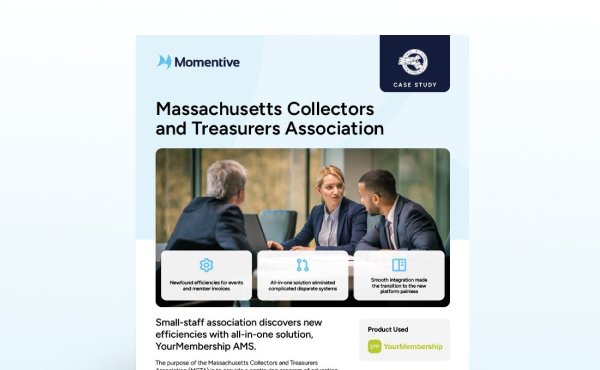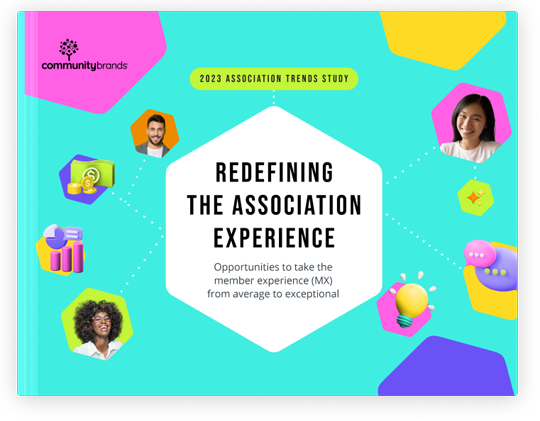Are your small staff association’s learning opportunities keeping up with the competition?
Professional development has become one of the most important benefits associations can provide to their members. Today’s professionals aren’t just joining an association for networking or advocacy; they’re looking for meaningful, career-advancing education.
According to the Benchmark Report: Small Staff Associations, 51% of members prioritize certifications or credentials as the most important benefit. Additionally, half of the members surveyed said ongoing training was one of the most important membership benefits. However, only 37% of small staff associations prioritize certifications or credentials and ongoing training opportunities as important organizational benefits.
While many small-staff associations already offer courses, certifications, and continuing education, the real differentiator lies in how seamlessly those experiences connect to the rest of the member journey. That’s where the integration of your Association Management System (AMS) and Learning Management System (LMS) comes in. When these two platforms work together, your association can deliver more learning options and a smoother, personalized, valuable member experience.
Continue reading to explore why an AMS + LMS integration is vital, how it benefits members and staff, and what best practices small-staff associations can follow to get the most from their investment.
The state of member learning expectations
Recent association trends research found that two-thirds of members reported they are required to take professional education and training courses to comply with industry standards. Of those, most turn either to their employer or their professional organization for continuing education opportunities.
However, there are two challenges identified in the research:
- Competition is strong
Other education providers like universities, independent trainers, and commercial platforms are close behind associations in fulfilling members’ learning needs. - Satisfaction is average
When asked to rate the quality of training, members gave their professional organization an “average” score compared with alternatives.
This signals both a risk and an opportunity. Members want to learn from their association, but if the experience isn’t streamlined, modern, or compelling, they may look elsewhere to receive professional development.
What members want from professional education
The research study also revealed that members are interested in more learning modalities than their associations typically provide. Professionals today don’t just want traditional classroom-style training or lengthy workshops.
Instead, they expect flexibility and variety:
- Webcasts of live events—Extending conferences and seminars to remote participants.
- On-demand learning – Content accessible anytime, anywhere.
- Mobile learning – Education delivered seamlessly on phones and tablets.
- Just-in-time learning – Quick, searchable resources that solve immediate problems.
- Short videos – Bite-sized microlearning content.
- Recommended courses – Personalized paths based on member profile or past learning.
- Social learning – Peer-to-peer discussion, collaboration, and shared knowledge.
Delivering all these formats consistently is challenging—especially for small staff associations. That’s why technology, and particularly integration between AMS and LMS, becomes essential.
Why integration matters beyond technology
On their own, an AMS and an LMS are powerful tools, but when they’re siloed, they create friction for both members and staff. Integration closes the gap, creating a single ecosystem for membership and learning.
For members: A seamless, personalized experience
Here are the top four ways your members benefit from an AMS + LMS integration:
- Single Sign-On (SSO)
Members don’t want multiple logins. With integration, one set of credentials unlocks both their membership profile and their learning portal. - Automatic credit tracking
Certifications, CE credits, and course completions flow directly into the member record, giving members one place to track their progress. - Personalized recommendations
The AMS holds demographic, professional, and interest data. The LMS tracks learning behaviors. Together, they deliver tailored learning suggestions that align with career goals. - Consistent branding
Members see your association as one unified organization, not a collection of disconnected platforms.
For staff: Efficiency and insight
Here are the top four ways your small staff benefit from an AMS + LMS integration:
- Data accuracy
No more double entry or mismatched records between systems. Integration ensures a single source of truth. - Streamlined workflows
Staff spend less time managing rosters, updating course access, or manually issuing credits. - Deeper analytics
Combined AMS and LMS data provide a 360-degree view of how education drives member engagement, renewals, and non-dues revenue. - Scalable operations
Staff can focus on strategy—like developing new courses—rather than being bogged down in administrative tasks.
The business case for AMS+LMS integration
Associations that successfully integrate these systems gain more than just convenience. They position themselves for growth, sustainability, and competitive advantage.
- Enhanced member value
Members are more likely to renew when they feel their association directly supports their career goals. Integrated systems make professional development seamless, increasing loyalty. - Non-dues revenue opportunities
Courses, certifications, and learning bundles can become year-round revenue generators. Integration enables easy e-commerce, member vs. non-member pricing, and promotional offers. - Strategic decision-making
Integrated reporting shows how learning impacts member engagement. Associations can identify which courses drive renewals, which segments are most active, and where to invest next. - Competitive differentiation
In a crowded learning marketplace, offering a professional, personalized, and easy-to-use platform sets your association apart from third-party providers.
How to deliver more of what members want
Meeting rising member expectations doesn’t mean overextending your staff or budget. By taking a strategic approach by listening to your members, refining your content, and leveraging technology that works seamlessly together, your small staff can deliver more of the learning opportunities professionals are asking for, while strengthening your association’s value.
- Step 1: Ask your members
Surveys remain one of the most powerful tools in your AMS. Find out what skills, certifications, and formats your members need most. Are they asking for leadership development? Technical skills? Microlearning? Use the data to prioritize your education strategy.
- Step 2: Revisit your content strategy
Align your catalog of courses with member needs. Retire outdated sessions, refresh popular topics, and explore new formats like podcasts or interactive modules. Integration helps ensure that these updates flow automatically into your member portal and learning catalog.
- Step 3: Invest in technology that connects
An LMS is no longer a “nice-to-have.” But the real return on investment comes when your LMS connects with your AMS.
Look for:
- Pre-built integrations
- Single Sign-On capabilities
- Automated credit tracking
- Unified e-commerce
- Reporting dashboards that pull data from both systems
Best practices for a successful integration
A successful AMS+LMS integration requires careful planning, clear priorities, and a thoughtful rollout. By following a set of best practices, your small-staff association can ensure the integration delivers on its promise: a seamless member experience, streamlined staff operations, and measurable impact on engagement and revenue.
Follow these five best practices to begin your AMS+LMS integration:
- Define your system of record
Decide which platform holds core member data (usually the AMS) and which holds course-specific data (the LMS - Prioritize data quality
Clean your records before integrating to avoid duplications or errors. - Start with core features
Focus first on SSO, credit tracking, and e-commerce before expanding to advanced personalization. - Communicate internally
Train staff on how to use the integration and make sure everyone understands the new workflows. - Measure success
Track metrics such as course enrollment, member satisfaction, and revenue growth to assess impact.
The future of an AMS+LMS integration
As technology evolves, integration will only become more important. Emerging AMS+LMS trends include the following:
- AI-driven recommendations
Suggesting courses based on career stage or job function.
- Microlearning expansion
Delivering education in smaller, more flexible formats.
- Interoperability standards (like LTI)
Allowing associations to plug in best-of-breed tools into their LMS seamlessly.
- Analytics for retention
Using learning data to predict and prevent membership churn.
Small-staff associations that invest in integration now will be better prepared to adapt to these innovations, and to keep meeting rising member expectations.
AMS+LMS integration FAQ
1. What is the difference between AMS and LMS?
A Learning Management System (LMS), on the other hand, is software designed to deliver, track, and manage educational content such as courses, certifications, webinars, and continuing education credits.
In short:
- AMS = member management and engagement
- LMS = education delivery and tracking
2. What is AMS integration?
AMS integration refers to connecting the AMS with other platforms, like an LMS, event software, or payment systems, so that data flows seamlessly between them. For example, when a member updates their profile in the AMS, that change automatically reflects in the LMS. This eliminates duplicate data entry, ensures accuracy, and creates a unified member experience.
3. What are LMS integrations?
LMS integrations are the connections between the LMS and other systems an association uses, such as:
- AMS (to sync member data, credits, and access permissions)
- E-commerce platforms (to handle payments for courses or certifications)
- Webinar tools (like Zoom or GoToWebinar for live sessions)
- Credentialing or badging systems (to award digital certificates)
These integrations expand the LMS’s functionality and help associations deliver a more seamless, engaging learning experience.
4. How do AMS contribute to communication and collaboration?
An AMS enhances communication and collaboration in several ways:
- Centralized member database Staff have one place to access accurate member information, reducing silos.
- Targeted communications Built-in email and messaging tools allow associations to send segmented, personalized messages based on member demographics, interests, or behavior.
- Event and community tools Many AMS platforms include discussion forums, committees, or event portals that encourage collaboration among members.
- Automated workflows Reminders, confirmations, and updates are sent automatically, keeping members and staff aligned.
Together, these features help associations keep members engaged, connected, and informed.
Learn more about AMS+LMS integration
Delivering high-quality professional education is no longer optional—it’s expected. But to rise above “average” satisfaction and stand out against other providers, small-staff associations need more than just content. They need connected systems that support the entire membership journey.
By integrating your AMS and LMS, you can give members a seamless, personalized experience, empower staff with efficient workflows and data-driven insights, and provide new opportunities for engagement, loyalty, and revenue.
An AMS + LMS integration isn’t just about technology, it’s about elevating your small-staff association’s value proposition and securing its future in a competitive learning landscape.






